
Andretti, Parnelli Jones & Team USA
Atlas F1 Senior Writer
Formula One is the pinnacle of motor racing worldwide, and yet no North American team has successfully competed in the championship for decades. In a two-part feature, Thomas O'Keefe looks at the reasons for this anomaly in his in-depth history of the last team, and the characters behind it, from those shores to competitively take the challenge to the Europeans.
Parnelli Jones probably never dreamed when he was racing hot rods and jalopies in local race meets as a youth in Torrance, California that sleek Grand Prix cars bearing his name would someday challenge the best that Europe had to offer on racetracks around the world with glamorous-sounding names like Monaco, Buenos Aires, Anderstorp, Kyalami, Montjuich Park, Nurburgring, Monza and Zandvoort. And yet it happened because of the strange confluence of people he met during his career at another famous racetrack - the Indianapolis Motor Speedway - where Parnelli Jones won the 1963 Indianapolis 500 in a front-engined Offy roadster, narrowly beating back the challenge from the rear-engined Lotus-Ford driven by his Scottish rival, Jim Clark.
Although representing a completely different racing tradition, oval track racer Jones had a lot of respect for Team Lotus and the "funny cars" Clark and Colin Chapman brought to Indianapolis that ultimately revolutionized Indycar racing. Indeed, had Jim Clark not been killed at Hockenheim in April 1968, Jones and Clark were to be matched as teammates in the 1968 Indianapolis 500 in a twin turbines team run as a joint venture by STP and Team Lotus.
By the early 1970's, Jones and his business partner, Vel Miletich, had formed a broad-based race team called "Vel's Parnelli Jones Racing" and one of their cars, a "VPJ Colt" called the "Johnny Lightning Special" won the Indy 500 in 1970 and 1971, driven by Al Unser Sr. The race team was an extension of their business, which included Ford dealerships and a chain of 45 Firestone tire retail stores. Jones and Miletich first met in 1956 when Jones was driving a 1937 Ford sponsored by Miletich. Jones was 23 years old then; Miletich was 31. Somehow, Jones, born in Texarkana, Arkansas, and Miletich, the son of Yugoslavian immigrants, saw eye to eye and remained close friends and business partners until Miletich died of leukemia in 1998.
Mario Andretti was another driver that raced for Miletich in his early days as a sprint car driver, and in the 1972-1975 Indy 500's Andretti had run the red, white and blue Viceroy-sponsored "Parnelli" or Eagle for the Vel's Parnelli Jones team. Mario had also raced in the occasional Grand Prix during 1968-72, driving for Lotus, March and Ferrari, though he always squeezed these races in around his Indycar career and thus never raced a full Formula One season. From his days with Lotus, Andretti also knew Maurice Phillippe and respected him as a designer and for his ability to work with a driver in setting up a car. Indeed, Andretti credited Phillippe with Andretti's being able to qualify on pole in the Lotus 49 at Watkins Glen for the 1968 U.S. Grand Prix, Andretti's very first Grand Prix; a stunning achievement then or now. You tend to remember a man that helped you do that.
Having won back-to-back Indy 500 victories in 1970 and 1971, the Vel's Parnelli Jones Racing Team expanded in 1972 and hired an impressive trio of drivers to try to win the Indianapolis 500 again: Al Unser Sr., Joe Leonard and Mario Andretti. Unser and Andretti had both won the Indy 500 and Leonard was the 1971 USAC Champion and had almost won the Indy 500 in 1968 when his Lotus turbine went out on lap 191 while in the lead when the turbine suffered a "flameout" on a restart.
While everyone on the Vel's Parnelli Racing Team knew of Maurice Phillippe and his achievements at Lotus, in his autobiography, A Driving Passion, Mario acknowledges that he was the one who "persuaded Jones and Miletich to hire Maurice Phillippe from Lotus to design an all-new [Indycar] for the team." What Phillippe came up with was the infamous dihedral-winged Parnelli VPJ1, a radical design with a shovel-shaped nose, huge NACA-style air ducts on its flanks and diagonal side wings that sprouted skyward at a forty-five degree angle from either side of the cockpit. But to Mario it looked unfinished somehow, as if the designer had lost his way after dreaming up the wild look of the car: "It wasn't too bad looking from the front, but the back was just forgotten. Everything was open, completely unclothed. It was so untidy. We asked Phillippe why and he had no answer."
By 1973, Phillippe had seemingly learned his lesson and designed a more conventional-looking Indycar in which Al Unser had led the 1973 Indy 500 race before dropping out on lap 75 with a broken piston in his Offy turbo; Andretti went out even earlier on lap 4 with a burned piston. The 1973 version of the Parnelli chassis did manage to set two closed-course speed records in 1973, clocked at over 214 mph in October 1973 at the Texas Motor Speedway.
The American Lotus
In 1974, all these Indy 500-based friends and colleagues came together to take the plunge into Formula One as an American team, albeit with a British accent. Ex-Team Lotus fixtures like designer Phillippe were joined on Parnelli's team by ex-Lotus Crew Chief Dick Scammell (who wielded the wrench on Jim Clark's Grand Prix and Indianapolis Lotuses) and ex-Lotus Team Administrator Andrew Ferguson, who had number-crunched for Colin Chapman and for John Cooper in prior incarnations and was the logistical genius behind the far flung worldwide activities of Cooper and Lotus in those days before 747 cargo jets.
Indeed, in his Cooper days, it was Ferguson who was responsible for getting Jack Brabham's Cooper to the Indianapolis Motor Speedway in 1960 for the historic test drive that proved the viability of the rear-engined car on the Speedway oval. Ferguson's tenure with the Parnelli team was brief, however. When Ferguson left the team after 1974, Jim Dilamarter, who had worked for Parnelli Jones and Vel Miletich since 1968, took over as Team Manager and Vice President of the race teams and Jim still manages both the Jones and Miletich businesses.
In addition to these refugees from Team Lotus and tried and true people who Jones and Miletich had known for years, Mario Andretti signed on to drive for what would be a one-car team. Firestone was the initial backer at the outset of the project (remember those 41 tire stores owned by Jones and Miletich) and Viceroy cigarettes and the red, white and blue paint scheme came over from Andretti's Indy cars of that era to the Formula One car, perfect for an American team.
Notwithstanding Phillippe's mixed results in designing the VPJ1, VPJ2 and VPJ3 Indycars, it was hoped that Phillippe's skills as a designer would come to the fore in creating the VPJ4 Grand Prix car. As Mario Andretti recalls, "we thought F1 would be his forte."
Off to a Quick Start: 1974
Andretti and the Parnelli VPJ4, chassis 001, made their debut on September 22, 1974 at the 1974 Canadian Grand Prix, held that year at Mosport Park; only two races were left in the season at that point, the Canadian and the U.S. Grands Prix, so entering the Parnelli that late in the season was clearly for learning purposes. Even though this was indeed the "Ford Cosworth Formula One" era for the most part, which tended to level the playing field for a newcomer like the Parnelli Jones team, the competition among the Cosworth-engined runners was fierce.
In the Parnelli's first race, the grid was a Who's Who of Grand Prix Racing. In addition to the Lotus 72E's of Peterson and Ickx, Emerson Fittipaldi in the Marlboro Team Texaco McLaren Ford and Clay Reggazzoni of Ferrari struggled all year against one another for the 1974 World Championship which Fittipaldi ultimately won. Carlos Reutemann and Carlos Pace ran the beautiful Brabham BT44's designed by Gordon Murray for team owner Bernie Ecclestone. Jody Scheckter won two races for Elf Team Tyrrell and Niki Lauda did the same for Ferrari. Denny Hulme, the 1967 World Champion was also in the race, driving a McLaren-Ford.
Graham Hill, who had won the Indy 500 in 1966 as a rookie and had been a Formula One Champion in 1962 and 1968, was by now an owner-driver and his Embassy Racing team entered two Lolas for Hill and this teammate Rolf Stommelen. Roger Penske was the other American entrant making his debut at this 1974 Canadian Grand Prix, with Mark Donohue as his driver, who had won the 1972 Indy 500, Penske's first win, in the Sunoco McLaren. In Formula One, Donohue would drive the very first Penske chassis, "Penske PC 1." James Hunt and his Hesketh were also in their first season. Hans Stuck drove a March along with teammate Vittorio Brambilla. Even Frank Williams was there, running the Iso Marlboro FW Ford Cosworth entry for Jacques Laffite and Arturo Merzario. In these races, it was not uncommon to have a field of 26 cars or more.
In such rarefied company, although future two-time Indy 500 winner Fittipaldi (1989 and 1993) won the 1974 Canadian Grand Prix, Andretti turned in a most creditable performance in the No. 55 Parnelli, painted red over white with an American flag up by the airbox and Firestone, Viceroy and Castrol decals on the flanks of the VPJ4. Andretti qualified down in 16th but after a spirited race with Denny Hulme for sixth place managed to finish in 7th place with the new car, ahead of the Brabhams and the Hills; Mark Donohue's debut finish in the Penske was 12th place. Ronnie Petersen's Lotus 73E finished in third place and Jacky Ickx's 72E finished behind Andretti in 13th place, so the American Lotus stood up well against it British cousin.
On October 6, 1974, the second race for the Parnelli team was run on home ground, the U.S. Grand Prix at Watkins Glen in upstate New York. The weekend started like a fairy tale and ended up like a nightmare. Amazingly, during Friday afternoon, Andretti thrilled the American fans by putting VPJ4/001 on provisional pole with a time of 1:39.209. Throughout most of Saturday's practice, Andretti's time held up but halfway through the session Andretti had brake failure and an off, damaging the nose and the steering. The Parnelli team got the car repaired but there were only 10 minutes left in the session and Carlos Reutemann in the Brabham and James Hunt in the Hesketh were able to improve upon Andretti's time, Reutemann taking pole position at 1:38.978. Even so, Andretti had nothing to be ashamed of, and he ultimately qualified in an astounding third place in only the second race for the team.
Unfortunately, locking in a high spot on the grid was as close as Andretti ever got to the front. During the parade lap, Andretti experienced ignition problems and returned to the pits. The start of the race was suspended to give the Vel's Parnelli Jones Racing Team mechanics enough time to cure the spark problem. In the wings sat French driver Jose Dolhem in his Surtees TS16, whose car did not qualify, but was the first car in reserve. Dolhem stood ready to be the chief beneficiary of Andretti's problem and take his place on the grid as the VPJ4's mechanics tinkered furiously in the pits.
Other events of a sad nature also took place at this 1974 U.S. Grand Prix. Dolhem's teammate at Surtees, Austrian Helmuth Koinigg, in only his second Grand Prix, had a rear tire go down and crashed fatally when the bottom rail of the Armco barrier let go on impact while the top element stayed in place.
This was also Graham Hill's last drive at Watkins Glen. He had won the U.S. Grand Prix three years in succession with BRM in 1963, 1964 and 1965, but in this his last race there, the Embassy Hill Lola finished out of the points in eighth place.
The Second Season: 1975
For the Parnelli team there was exhilaration at the strength shown during qualifying for Watkins Glen in 1974, but an ominous commercial development loomed large in the team's future in the off season. Firestone, the main sponsor for the team, announced its withdrawal from Formula One. A financial settlement of $1.5 million was paid by Firestone to Vel's Parnelli Jones Racing Team to mitigate the damage.
In addition to the loss of sponsorship dollars and development support from Firestone, the construction and compound of the Firestone tires were an integral part of the VPJ4's chassis package, which combined a firm suspension with the softer sidewall construction of the Firestone tires. Maurice Phillippe's Lotus 72 was also originally designed around the softer Firestone tires and it was found by Team Lotus that the switch by Lotus to stiffer sidewall tire provided by Goodyear in 1973 played havoc with the handling of the Lotus 72. Since the VPJ4 had some of the same inherent design characteristics as the Lotus 72 the Parnelli team hoarded its supply of Firestone rubber at the end of the 1974 season to be used to the extent they could be for the 1975 season.
As the 1975 Formula One season got underway on January 12, 1975 in Buenos Aires for the Grand Prix of Argentina the team capitalized on the Bicentennial spirit building in the United States for the celebrations of 1976 and adopted the logo "Team USA" on the flanks of the car. The chassis used was a new one, VPJ4/002. Andretti also had a new number, No. 27.
As the only team running on Firestone tires in Buenos Aires, Mario did well to qualify 10th in a field of 23 cars, but in the race an inboard brake shaft CV joint and transmission problems put him out on lap 27 of a 53-lap race, leaving him among the unclassified. The inboard brake shaft failure in Buenos Aires was an early sign of what would turn out to be an Achilles Heel for the Parnelli Grand Prix car.
In the next race at Interlagos for the Brazilian Grand Prix on January 26, 1975 the VPJ4 was on Goodyear tires, and although Andretti qualified well down in 18th place in the race he finished a remarkable 7th, just of out the points and behind the better-established teams like Ferrari (which finished in 4th and 5th place), McLaren (which finished in 2nd and 3rd place) and Brabham's Carlos Pace, who won his only Formula One race that day, happily, before his fellow Brazilians.
Notwithstanding the VPJ4's initial good showings, Andretti himself was having qualms about the car and Phillippe's capacity to cure its faults and improve the car as the season wore on. General speaking, the handwriting was on the wall for the Lotus 72 design by 1975; even the Lotus 72E was showing its age by the 1975 season, when the Lotus 72E won no races and scored only a handful of points even in the capable hands of Ronnie Petersen and Jackie Ickx.
At Kyalami in South Africa on March 1, 1975, Andretti was back in good form, qualifying VPJ4/002 in 6th place and running in 7th place in the race until the perennial problem struck, as in Argentina, when the inboard front brake shaft CV joint went out on lap 70 of the 78-lap race; Andretti ended up classified in 17th place. Why were the inboard brakes and the related CV joint such a recurring problem? Apparently, these brake shaft failures were due to the inferior CV joints available, and in time the team went to outboard brakes to eliminate this weak spot in the car's design.
On April 27, 1975 the Spanish Grand Prix was held at the Montjuich Park circuit in Barcelona. It was an extraordinary race on a lot of levels. First, there were safety issues because the drivers discovered that the temporary Armco barriers erected by the organizers had been poorly done, with many bolts missing that held the Armco together. In the end, then-World Champion Emerson Fittipaldi pronounced the circuit too dangerous to race because of concerns about safety.
Second, there were serious accidents in the race that resulted not from missing Armco bolts but from other causes. The Ferrari's of Lauda and Reggazzoni were on the front row but collided with one another on lap 1 in the first corner and the rear suspension upright of Andretti's Parnelli was also damaged in the shunt, apparently when Vittorio Brambrilla's March hit Andretti in the rear. Then tragedy really struck on lap 25 when the rear wing support broke on Rolf Stommelen's Hill-Ford and the car crashed over the barriers, killing five spectators.
Third, for all the tragedy of the loss of life that afternoon, in truth the Spanish Grand Prix turned out to be something of a highwater mark for the Parnelli team. Andretti qualified in fourth place and after the Ferrari teammates took each other out at Turn 1 James Hunt, who had qualified in third place, took the lead and held it for the first six laps, with Andretti close behind in second place until Hunt also had a shunt, allowing Andretti to take the lead in the Parnelli and hold it for 10 laps.
Sadly the Parnelli's rear suspension failed, a delayed reaction to the impact of the Turn 1 contretemps involving the Ferrari's and Brambrilla. But before the suspension failure had put him out of the race, Andretti had actually experienced the thrill of leading a Grand Prix in the Parnelli VPJ4, a considerable achievement for any Grand Prix car no matter what the circumstances. Andretti had also set fastest lap.
Andretti remembers how well the car was set up that Sunday in Montjuich Park: "We could have won in Barcelona. I was able to drive that car sideways. It was really working. I caught Hunt and passed him, and I was truly gone. But there was quite a bit of vibration in the rear tires under acceleration and finally the upright just snapped."
Finally, the 1975 Spanish Grand Prix was red-flagged on lap 29 after only 68 miles because of the Stommelen accident and half points were awarded to those still running. Included among the drivers in the points was a women, Lella Lombardi, who was driving a March in her second Grand Prix. She was awarded one-half of a point for finishing sixth in the shortened race and that result continues to this day to be the only time a woman driver has scored points in Formula One.
To be continued next week...
Part I
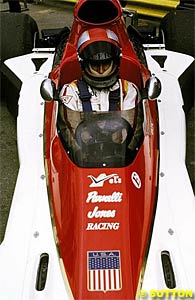 During the Lotus turbine project, Jones got to know the work of one of Chapman's designers, Maurice Phillippe, a brilliant English aerodynamicist, who had designed the wedge-shaped Indianapolis turbine cars, the Lotus 56. In Grand Prix racing, Phillippe had penned the Lotus 72, the elegant Cosworth-powered black beauty known as the John Player Special, that was as fast as it was easy on the eyes and brought World Championships to Team Lotus in 1972 and 1973.
During the Lotus turbine project, Jones got to know the work of one of Chapman's designers, Maurice Phillippe, a brilliant English aerodynamicist, who had designed the wedge-shaped Indianapolis turbine cars, the Lotus 56. In Grand Prix racing, Phillippe had penned the Lotus 72, the elegant Cosworth-powered black beauty known as the John Player Special, that was as fast as it was easy on the eyes and brought World Championships to Team Lotus in 1972 and 1973.
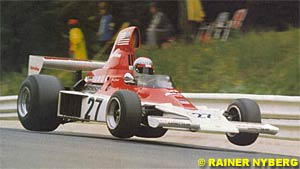 And the VPJ1 did turn out to be an inauspicious beginning for the high-powered team once it hit the racetrack. Soon the dihedral side wings were jettisoned and the car was shaped up by master Indycar mechanic George Bignotti. After overcoming chassis design and engine problems at the 1972 Indy 500, Unser and Leonard miraculously finished second and third and Andretti finished eighth in the Phillippe Parnelli.
And the VPJ1 did turn out to be an inauspicious beginning for the high-powered team once it hit the racetrack. Soon the dihedral side wings were jettisoned and the car was shaped up by master Indycar mechanic George Bignotti. After overcoming chassis design and engine problems at the 1972 Indy 500, Unser and Leonard miraculously finished second and third and Andretti finished eighth in the Phillippe Parnelli.
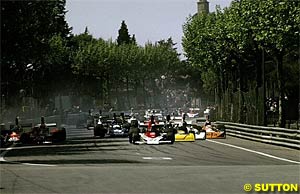 Maurice Phillippe's design understandably drew upon his prior handiwork in Formula One, the Lotus 72 Grand Prix car, which was still running in Formula One as the updated Lotus 72E in the hands of Team Lotus drivers Ronnie Peterson and Jacky Ickx, and the 72E was still winning races though now in its last stage of development. The layout of VPJ4, the first chassis, had a wedge shape like that of the Lotus 72, a rear wing tray well back out beyond the rear wheels, hip radiators aft of the cockpit, torsion bar suspension, inboard brakes front and rear and the Ford Cosworth DFV3.0 V8 Hewland engine/transmission combination that virtually every car on the grid had during that era of Formula One, except for Ferrari and BRM, both of which made their own V12 engines.
Maurice Phillippe's design understandably drew upon his prior handiwork in Formula One, the Lotus 72 Grand Prix car, which was still running in Formula One as the updated Lotus 72E in the hands of Team Lotus drivers Ronnie Peterson and Jacky Ickx, and the 72E was still winning races though now in its last stage of development. The layout of VPJ4, the first chassis, had a wedge shape like that of the Lotus 72, a rear wing tray well back out beyond the rear wheels, hip radiators aft of the cockpit, torsion bar suspension, inboard brakes front and rear and the Ford Cosworth DFV3.0 V8 Hewland engine/transmission combination that virtually every car on the grid had during that era of Formula One, except for Ferrari and BRM, both of which made their own V12 engines.
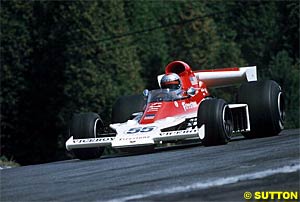 Sympathetic to the popular American's plight, the experienced Watkins Glen starter Tex Hopkins waited for a prudent period to let Andretti get his car on the grid, but when he finally dropped the green flag to start the race Andretti's Parnelli did not budge. It seems that although the sparkbox had now been replaced, the engine refused to fire because of a fuel vapor lock caused by the hot engine sitting there while the electrical problems were being sorted out. Since Andretti was third on a grid with 27 cars on it, Mario began waiving his arms to alert the 20 or so drivers behind him, who then scrambled around him and luckily avoided a collision. Finally, the Parnelli crew pushed the VPJ 4 off to the side of the track, resolved the vapor lock problem and gave Andretti a push start. But because the push start was outside of the pit area it was regarded as illegal assistance and a violation of the rules. Andretti was black-flagged after four laps and disqualified.
Sympathetic to the popular American's plight, the experienced Watkins Glen starter Tex Hopkins waited for a prudent period to let Andretti get his car on the grid, but when he finally dropped the green flag to start the race Andretti's Parnelli did not budge. It seems that although the sparkbox had now been replaced, the engine refused to fire because of a fuel vapor lock caused by the hot engine sitting there while the electrical problems were being sorted out. Since Andretti was third on a grid with 27 cars on it, Mario began waiving his arms to alert the 20 or so drivers behind him, who then scrambled around him and luckily avoided a collision. Finally, the Parnelli crew pushed the VPJ 4 off to the side of the track, resolved the vapor lock problem and gave Andretti a push start. But because the push start was outside of the pit area it was regarded as illegal assistance and a violation of the rules. Andretti was black-flagged after four laps and disqualified.
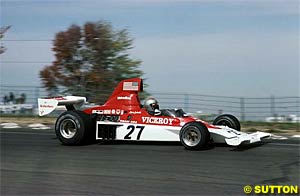 On April 13, 1975 at the non-Championship but prestigious BRDC International Trophy Race, Andretti had one of his good days in the American Parnelli at Silverstone, the home of British Racing, qualifying 10th but finishing third behind Emerson Fittipaldi's McLaren M23 and Niki Lauda's Ferrari 312T, the cream of the crop of that era. Even though the race was only 177 miles, shorter than the usual Grand Prix which tended to be closer to 200 miles, it was significant that the Parnelli could keep such fast company.
On April 13, 1975 at the non-Championship but prestigious BRDC International Trophy Race, Andretti had one of his good days in the American Parnelli at Silverstone, the home of British Racing, qualifying 10th but finishing third behind Emerson Fittipaldi's McLaren M23 and Niki Lauda's Ferrari 312T, the cream of the crop of that era. Even though the race was only 177 miles, shorter than the usual Grand Prix which tended to be closer to 200 miles, it was significant that the Parnelli could keep such fast company.
Please Contact Us for permission to republish this or any other material from Atlas F1.
|
Volume 9, Issue 47
Articles
Sixteen Sundays, Part I
2004 Countdown Facts & Stats
The Fuel Stop
The Montoya Trivia Quiz
Columns
Bookworm Critique
On the Road
Elsewhere in Racing
The Weekly Grapevine
> Homepage |